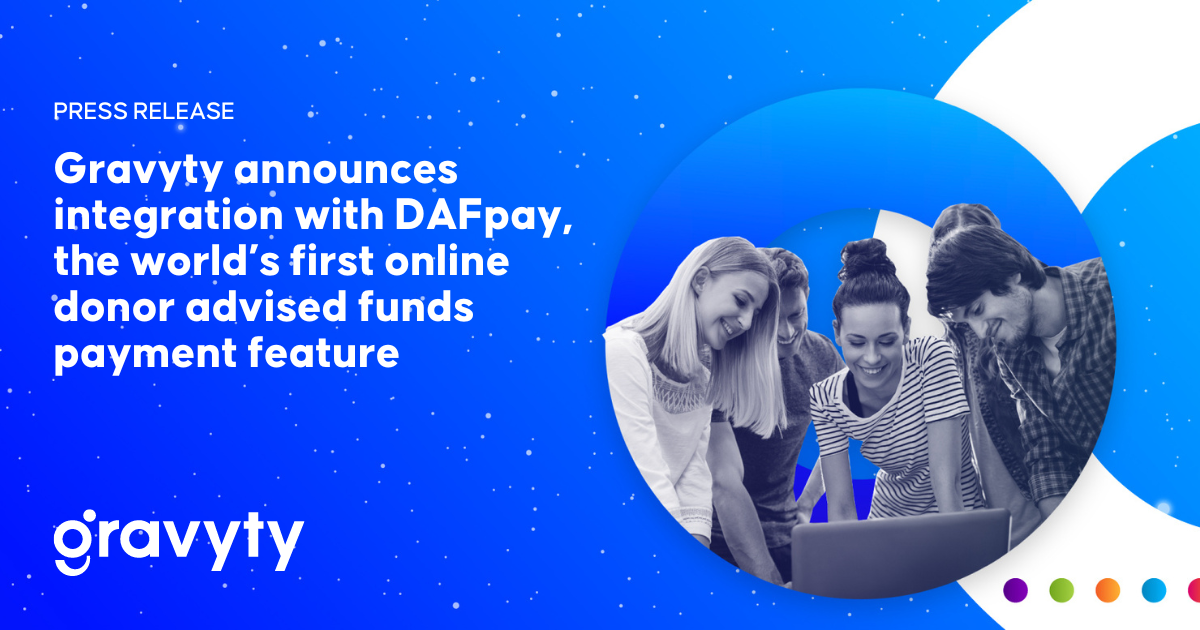Donor advised funds for nonprofits: Definition, FAQs & how to use them to boost giving in 2024

There’s no doubt about it: donor advised funds, also known as DAFs, are the fastest growing vehicle in philanthropy. The number of DAF accounts has nearly tripled over the last four years, and they make up 17% of annual giving in the United States as of 2022 (up from just 7% five years ago).
And it’s not just the ultra-wealthy using DAFs. While the average DAF balance is $183K, 56% of accounts are less than $25K. Additionally, research shows people with DAFs are 63% more likely to donate.
The growth isn’t slowing down anytime soon. With $230 billion sitting in DAF accounts ready to be donated, nonprofit organizations need to adapt fundraising strategies now in order to benefit from this lucrative giving vehicle for years to come. Here, we break down what a DAF is and how it works, frequently asked questions and how to quickly ramp up your organization to raise more with donor advised fund donations.
What is a donor advised fund and how does a DAF work?
A donor advised fund (DAF) is a specialized financial account used for charitable giving. It allows individuals to make a charitable contribution, receive an immediate tax deduction and then make grants to 501(c)(3) organizations over time.
The money in a DAF can also grow tax free and be donated at any time in the future, and there are no time limits or distribution requirements for DAFs today.
Anyone can set up a DAF. Options of how to set up a DAF include:
- Through companies that provide banking services such as Fidelity, Vanguard or Schwab
- Newer startups dedicated to DAFs, like Daffy, Charityvest or Groundswell
- Often through local community foundations
Who uses DAFs?
Not just the ultra-wealthy—While the average DAF balance is $183K, 56% of accounts are less than $25K.
Not just older people—The average age when someone opens a DAF is 55, but the fastest-growing group is younger than 40.
More active and engaged donors—People with DAFs are 63% more likely to donate.
People with DAFs contribute more than 11 grants per year, on average. People with DAFs have 24x larger average donation size.
Expecting an easy, digital process—40% of DAF donors at a leading digital fundraising charity first donated with a credit card on their website, according to private data shared from an online fundraising provider with Chariot. It’s nearly universal that DAF donors also donate with credit cards, according to internal analysis of DAF holder feedback.
3 reasons nonprofits should care about DAFs
- DAFs are big. They make up 17% of annual giving in the US as of 2022 (up from 7% in 2017). Per the National Philanthropic Trust 2023 DAF Report, annual DAF giving is now nearly $52 billion. While annual giving as a whole from DAFs makes up a large percentage, the stats on individual DAF donations are also large—the average donation from a donor advised fund is nearly $5,000, according to Fidelity’s 2023 Charitable Giving Report. This is much larger than the average one-time gift of $121.
- Giving from DAFs is still growing. Not only do DAFs make up a large (and increasing) portion of total annual giving, it’s also clear that charitable giving through DAFs is still increasing: the number of donor advised fund accounts has nearly tripled over the last four years.
- DAFs are reliable amongst economic turbulence. During economic uncertainty, donor advised funds are a dependable source of funding for charitable organizations. Because the money in DAF accounts has already been set aside for charity, it can’t be withdrawn for other purposes. Donors’ propensity to donate from a DAF is not as affected by financial pressures and economic woes.
Considerations of donor advised funds & what’s next
Historically, DAF giving has been far below its potential because high-value donors can have a poor experience and fundraising staff can be overburdened. Without a digital giving solution that integrates with a DAF payment option, DAF fundraising has been limited for many organizations because:
DAF giving has been too disconnected from broader fundraising efforts.
DAF giving can’t happen at the point of inspiration, like a referral link from a friend, an instagram ad or an in-person event. Giving from a DAF requires forethought and planning.
It’s been difficult to identify DAF donors and steward them accordingly.
New DAF donors typically give with a credit card first, leaving organizations in the dark as to who in their donor file has a DAF. Donor advised fund gifts often arrive without clear identifying details and never with email contact information. Even if a mailing address is included, your donation thank-you might be weeks delayed. No fundraising organization wants their highest potential donors to have a poor donor experience.
DAF giving has been a cumbersome process, which limits conversion.
The typical DAF giving process without Chariot, the creator of DAFpay™️, a payment option that lets donors give from their DAF to 501(c)(3) registered nonprofits directly through Gravyty’s digital fundraising platform, takes 15 steps, over three minutes and multiple redirects to complete, according to a Charity analysis of existing DAF donation processes.
Managing DAF gifts via check payment has required considerable staff effort.
It can take weeks for checks to arrive at organizations, often without identifying details that create a significant gift processing burden. Fundraisers often have to follow up with major donors to make sure DAF grants are completed.
Efforts to engage donors have been structurally hampered.
The most effective way to increase DAF donations is to educate donors about what donor advised funds are and how to use them. But it’s significantly less effective when explaining the DAF process is complex and so much time and effort is required to actually complete (and benefit from) DAF gifts.
Nonprofits that don’t address these challenges could be left behind, missing out on the exponential potential DAFs offer. Without a seamless giving experience, DAF donors will make more DAF donations where it’s easiest.
How nonprofits can identify DAF donors
For nonprofit fundraisers, finding DAF donors is mostly about making it easier for DAF donors to find you. Here are five tips for finding more donor advised fund donors to boost charitable giving to your organization:
1. Make it easier for donors to give with their DAF. Otherwise they’ll most likely give a much smaller gift with their credit card, or worse, not give.
2. Increase awareness that you’re able to accept DAF gifts. Market your capabilities to your donors and make the information prominent on your website and in donor communications.
3. Ask your donors about their DAFs. Don’t be afraid to ask your donors in a survey or directly in 1×1 conversations if they have a DAF set up.
4. Include DAF giving options wherever you acquire new donors, such as in your donation forms, on your peer-to-peer fundraising pages and at live events.
5. Make it easier for those with DAFs to give through a frictionless giving platform that incorporates a digital DAF payment option so donors can donate from their DAFs in minutes, not months.
Top 10 donor advised funds
According to National Philanthropic Trust’s 2023 DAF Report, the number of individual DAF accounts at National Charities grew 2.9 percent year over year, so it’s no surprise that more donors are seeking out donor advised fund providers. Here are the ten top donor advised funds that received the most contributions in 2021.
- Fidelity Charitable Gift Fund – $15.3 billion
- National Philanthropic Trust – $8.6 billion
- Schwab Charitable Fund – $7.1 billion
- Vanguard Charitable Endowment Program – $4.3 billion
- Silicon Valley Community Foundation – $4.0 billion
- American Endowment Foundation – $2.6 billion
- Morgan Stanley Global Impact Fund – $2.4 billion
- Goldman Sachs Philanthropy Fund – $2.1 billion
- Chicago Community Trust – $1.8 billion
- American Online Giving Foundation – $1.5 billion
FAQs about DAFs
What’s the difference between a donor advised fund vs. charitable trust?
A donor advised fund is a charitable giving account where donors contribute funds to a sponsoring organization and recommend grants to charitable organizations, retaining advisory privileges. A charitable trust is a legal entity with different types, such as Charitable Remainder Trusts or Charitable Lead Trusts, allowing donors to contribute assets for charitable purposes while often providing income to beneficiaries or charities according to the trust agreement.
DAFs offer flexibility and immediate tax benefits, while charitable trusts may have fixed terms, specific income distributions, and potential estate tax advantages, depending on the trust type.
Can a donor advised fund give to a private foundation?
In most cases, yes. A DAF can make grants to a private foundation. Donors with DAFs typically have the flexibility to recommend grants to a wide range of qualified charitable organizations, including private foundations. However, donors have to ensure that the private foundation meets the legal requirements and qualifies as a tax-exempt organization under the Internal Revenue Code.
Can donor advised funds donate to 501(c)(3) organizations?
Yes, donor advised funds can donate to 501(c)(3) organizations. In fact, 501(c)(3) organizations are typically the primary recipients of grants from DAFs. When donors contribute to a DAF, they can recommend grants to qualified charitable organizations, and most 501(c)(3) organizations fall into this category.
Donors should always check with the sponsoring organization of the DAF to understand any specific policies or restrictions related to grant recommendations.
Are donor advised funds tax deductible?
Yes, contributions to donor advised funds are generally tax-deductible. When donors contribute to a DAF, they can claim a charitable deduction on their income tax return for the year in which the contribution is made. This allows donors to receive an immediate tax benefit.
How can organizations support fundraising with donor advised funds?
Organizations can support fundraising with DAFs by promoting awareness of DAF payment acceptance among their donors and providing convenient options for contributions. This might include educating donors about the benefits of contributing through DAFs, offering assistance in the process and providing clear information on how to make contributions via a DAF to the organization.
Of course, expressing gratitude and acknowledging DAF donors for their contributions fosters ongoing support and life-long donor relationships.
How can you process donor advised fund donations?
Nonprofits can accept payments from donor advised funds through various methods, depending on the preferences and capabilities of the DAF sponsoring organizations. The most common methods include online giving platforms, electronic funds transfer (EFT), check, wire transfers, automated clearing house (ACH) transfers, and grant recommendation forms.
The future of fundraising with donor advised funds
The powerful fundraising vehicle that is donor advised funds is showing no signs of slowing down in 2024. DAFs provide donors with a flexible and tax-efficient way to contribute, and nonprofits can benefit from an increased pool of potential donors.
DAFs often lead to larger, more strategic donations, as donors have the opportunity to plan and recommend grants over time. At the same time, DAF contributions can be a reliable and consistent source of funding, offering nonprofits financial stability and the ability to plan for long-term projects. The administrative simplicity of DAF transactions, facilitated by DAF sponsoring organizations, allows nonprofits to focus more on their mission and less on managing individual donations, fostering stronger donor relationships and enhancing overall fundraising efforts.
Set your organization up for DAF success with a modern giving experience that accepts DAF donations seamlessly and digitally. Learn more about Gravyty’s digital fundraising platform.



